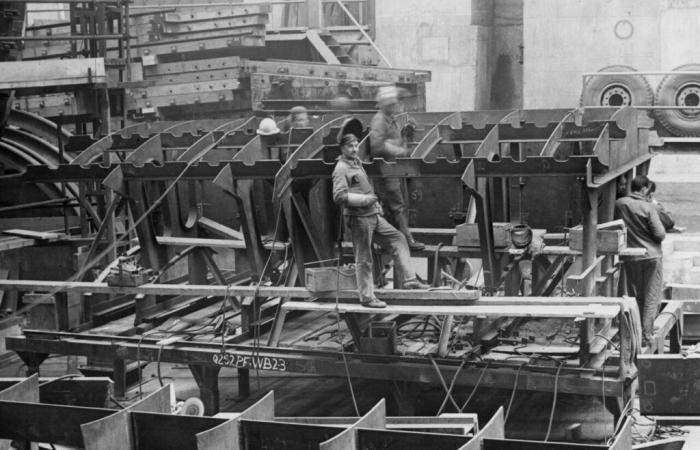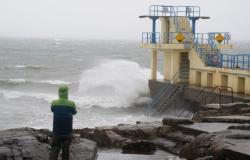Par
Editorial La Presse de la Manche
Published on
Nov. 6 2024 at 6:00 p.m
See my news
Follow La Presse de la Manche
Blacksmith by trade, Michel Guérard began in 1951 at the arsenal, after leaving the Arpètes school. After an interruption – he became a union representative for the CFTC – il found the Iron Buildings in 1966. The construction of the Formidable was already well underway.
“The most striking thing about this boat was its dimensions: 128 meters long, but above all 10.60 m wide… There was also a new hull steel, 80 HLES, very complicated to work with and restrictive to weld.”
The presses and cutting machines salvaged from the German occupiers were no longer sufficient and new machines arrived. Lifting means too, which required certain aisles to be concreted…
“For couples, we didn’t have tools big enough,” recalls Michel Guérard. A coupleit is a circular metal part, composed of a core – the interior part – and a sole welded perpendicularly, which contributes to the resistance of the hull. There are about a hundred of them The Redoubtable. “We cut sheets of sheet metal oxyacetylene torch. We worked in pairs, one for the interior, the other on the exterior, progressing at the same time. A little later, we developed a cutting cart… Each boat made us evolve”, agrees the blacksmith.
After the couples, he worked on the profiles, the angles, made hundreds of coamings (manholes), and then carlings, collars for the cables…
I finished my career on test models. In fact, we built the boat on a 1/10th scale, before sending it to the testing center, CETEC, where it was tortured to check the quality of the design.
In the hell of iron buildings
“They were terrible working conditions. Convict work”, remembers Michel Guérard when talking about the iron buildings. It is there, on the current location of the Laubeuf construction sitewhich were cut and formed the hull plates.
These “BF” contained a large nave two hundred meters long, and five naves around a hundred meters long. 500 people worked there, of all specialties: cutters, carpenters, grinders, chiselers… “The first things they gave us when we arrived were clogs and sleeves.
Clogs were our safety shoes. They had to be circled. The handles were for the tools, and the first test for the young worker was the way he handled his tools
The floor was dirt. “It was only watered twice a week. It was fine for half a day. Afterwards, with the pneumatic tools used, the dust was flying”says a former permanent member of the CFDT, Bernard Lechatreux. “The large doors of the buildings were open for a yes or a no,” adds Michel Guérard, who still sees the dust in suspension. And the simple buckets for washing your hands. And then there was the cold. “When the forges disappeared, we lit fire pits, with wood that we fetched from the Galet hold. And it was smoking!”, says Michel Guérard.
We also burned coke. With the dust, there were times when we could barely see
And there was the noisethe level of which regularly exceeded 100 decibels. “To protect ourselves, we were advised to put tow in our ears,” notes Michel Guérard.
Dad's brown
In the 1960s, Émile Poutas was an iron carpenter in the Cales sector. On The Redoubtablehe notably installed structures.
These were terrible working conditions. You had to sneak into the submarine, rubbing shoulders with preheaters, welders and many other specialties…
In the evening, he came home black and dirty… When you're a child, that's something. I was marked by these images testifying to the working condition,” remembers one of his sons, Jean-Marie Poutas.
In a box, he kept the invitation received by his father for the launch of the Formidablethat also for the reception. Émile Poutas had spent the night “blinding” before participating, from the bottom of the hold, in the launch. “He was a Gaullist, a left-wing Gaullist, but spoke of Grand Charles with great respect. I didn’t see him, but he must have been crying with pride that day.” The son also kept “dad’s chestnut”, a small metal disc, the diameter of a ping-pong ball, with an engraved number.
It was his number. When he arrived at work, he had to put it in the chestnut box.
This box is the ancestor of the time clock. “In this box, there were a bunch of small compartments in which everyone placed their chestnut. You had to point in blue. Five minutes late, sometimes only two according to the workshop managers, and we were put on the floor for half an hour on the pay slip,” all the veterans remember. Work started at 7:30 a.m. Four hours of work in the morning, interspersed with a snack “prohibited but tolerated”. Five o'clock in the afternoon. “Forty hours a week, but we often came back on Saturday.”
Jean LAVALLEY
Follow all the news from your favorite cities and media by subscribing to Mon Actu.






